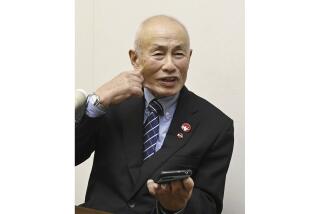3 Win Nobels in Chemistry for Molecular Studies
- Share via
A Swiss chemist who works part time in La Jolla, a Japanese and an American will share the 2002 Nobel Prize in chemistry for “revolutionary breakthroughs” that are helping scientists determine the complex structures of proteins and other large molecules that play key roles in living organisms.
The techniques they pioneered have led to quicker detection of cancers, development of drugs for a variety of diseases and new ways to monitor contamination of foods.
“They are enablers, toolmakers who gave chemists better ways to answer amazing questions about biological molecules,” said chemist Catherine C. Fenselau of the University of Maryland.
John B. Fenn, 85, of Virginia Commonwealth University in Richmond, and Koichi Tanaka, 43, of Shimadzu Corp. in Kyoto, Japan, will share half of the estimated $1-million prize for developing techniques to study large molecules by mass spectrometry.
Kurt Wuthrich, 64, of the Swiss Federal Institute of Technology Zurich and the Scripps Research Institute in La Jolla, will get the other half for applying the techniques of nuclear magnetic resonance imaging to macromolecules.
Tanaka, an engineer, is one of the very few science winners in the modern era who does not have a doctorate. He is the second Japanese winner this year; Masatoshi Koshiba of the University of Tokyo received the Nobel for physics Tuesday.
At a news conference in Tokyo, Tanaka said he received a phone call telling him to stand by for an important call, then a second call with “someone talking to me in English. I thought I heard a word, ‘Nobel,’ and ‘Congratulations,’ but I still had no idea what they were talking about.”
“I still can’t believe even now that I would win this kind of prize,” he said. “If I had known, I would have ... dressed in a suit and tie, so I apologize for my attire.”
Fenn said that he was “sort of overwhelmed” by the prize. “It was a bolt out of the blue. You can never expect these things, so I am still in a state of shock.”
At a news conference, Fenn said, “There’s an awful lot of luck in this. In fact, there’s a lot of luck in science. To succeed as a theorist, you have to be good. To succeed as an experimentalist, you only have to be lucky. As an experimentalist, you go through life kicking over a lot of stones and, if you’re lucky, you’ll find something.”
In Zurich, Wuthrich said he was “delighted and surprised” with the award.
“I’m glad that such a prize is coming to Switzerland. At a time when so much seems to be going wrong, this shows that certain things also have gone right.”
Wuthrich works part of the year at Scripps and said he will use some of the prize money to move his entire laboratory to La Jolla. He will become a full-time faculty member there in 2004, when he will face mandatory retirement in Switzerland.
This is the second year in a row that a Scripps researcher has received the chemistry prize. Last year, K. Barry Sharpless was awarded the chemistry Nobel for the development of new ways to synthesize asymmetric molecules.
Identifying biological molecules and determining their structures long have been a major focus of biology. Identifying which proteins and other large molecules are present in a cell gives powerful clues to how the cell works, and determining the precise structure of such macromolecules is necessary to determine how they carry out their functions.
The first useful method for determining protein structure was X-ray crystallography, and several Nobels have been awarded for its development and use. But crystallography is a laborious process, and it doesn’t necessarily reveal anything about a molecule’s shape when it is dissolved in a liquid--its natural habitat.
Mass spectrometry and nuclear magnetic resonance imaging are alternative ways to approach the problem. In mass spectrometry, a molecule is vaporized and ionized in a magnetic field. The time the ion takes to reach a detector reveals its mass, and the sizes of fragments that also reach the detector reveal much data about the original molecule’s structure.
Mass spectrometry long has been used for relatively small molecules. In the mid-1980s, Fenn and Tanaka found ways to apply it to much larger molecules. “We made elephants fly,” Fenn said.
Fenn dissolved the molecules in water, applied an electric current and sprayed the solution into the mass spectrometer. As the water evaporated, it left behind intact airborne proteins that were suitably ionized. Tanaka achieved the same feat by shining a laser beam on a small particle of the molecule to be studied.
Mass spectrometry shows the size and chemical composition of the molecules. Nuclear magnetic resonance provides three-dimensional structure. Like mass spectrometry, nuclear magnetic resonance was routinely used for studying small molecules in solutions. Wuthrich found a complex mathematical technique that allowed it to be applied to large molecules as well. His approach was similar to that used for magnetic resonance imaging in medicine.
The breakthroughs have proved extremely valuable for studying, for example, how enzymes carry out chemical reactions. The shape of an enzyme changes as it interacts with the chemicals it targets, and nuclear magnetic resonance has made it possible for the first time to determine both the before and after shapes.
More to Read
Sign up for Essential California
The most important California stories and recommendations in your inbox every morning.
You may occasionally receive promotional content from the Los Angeles Times.













